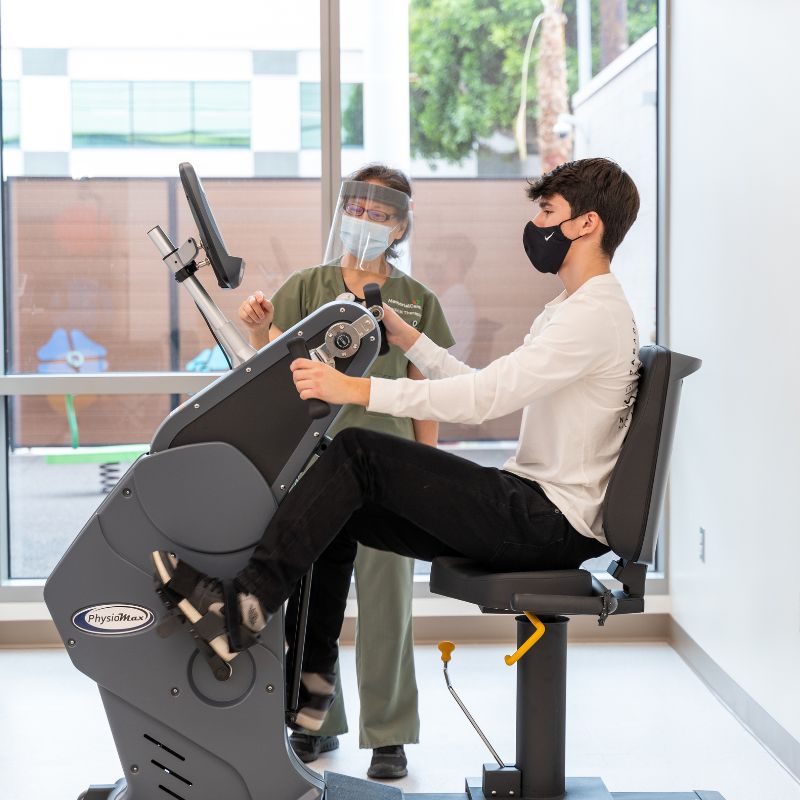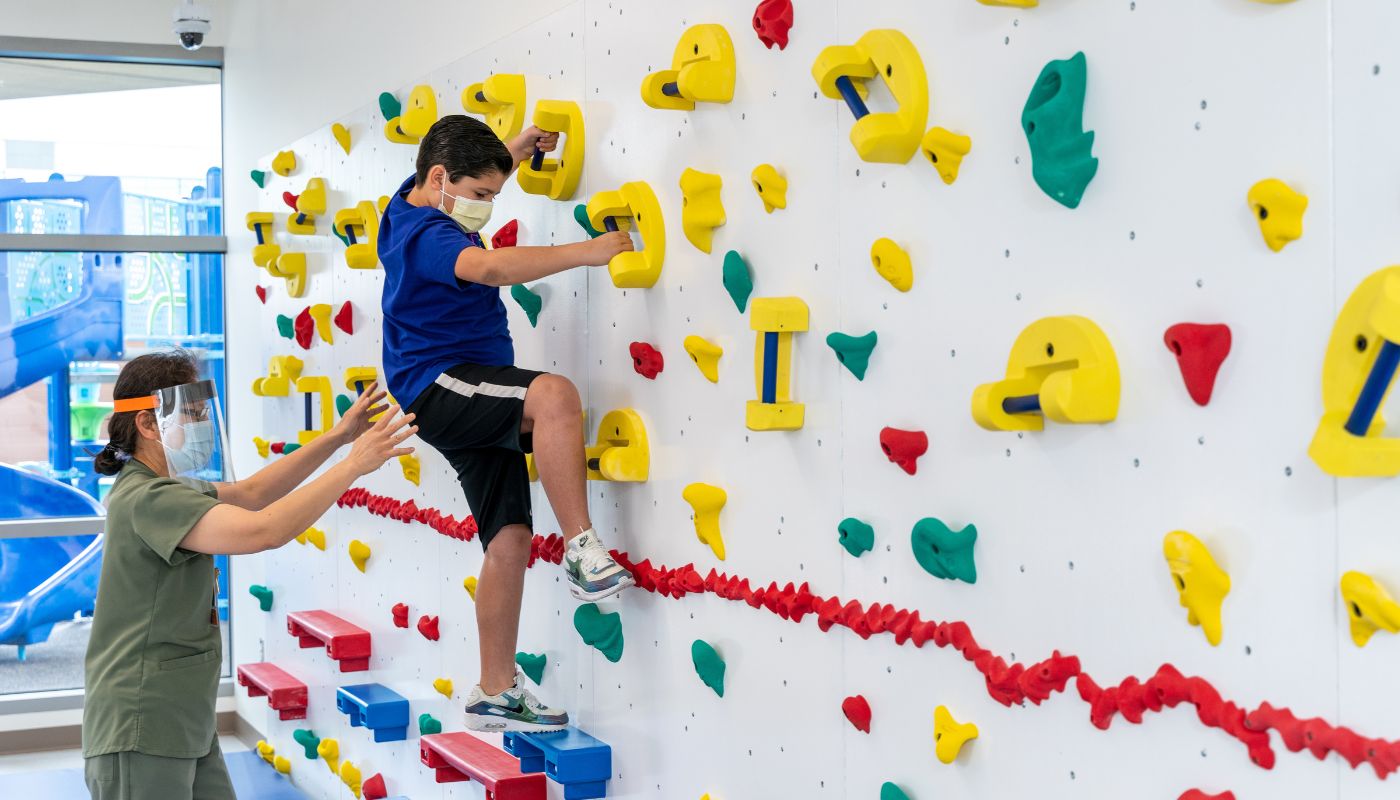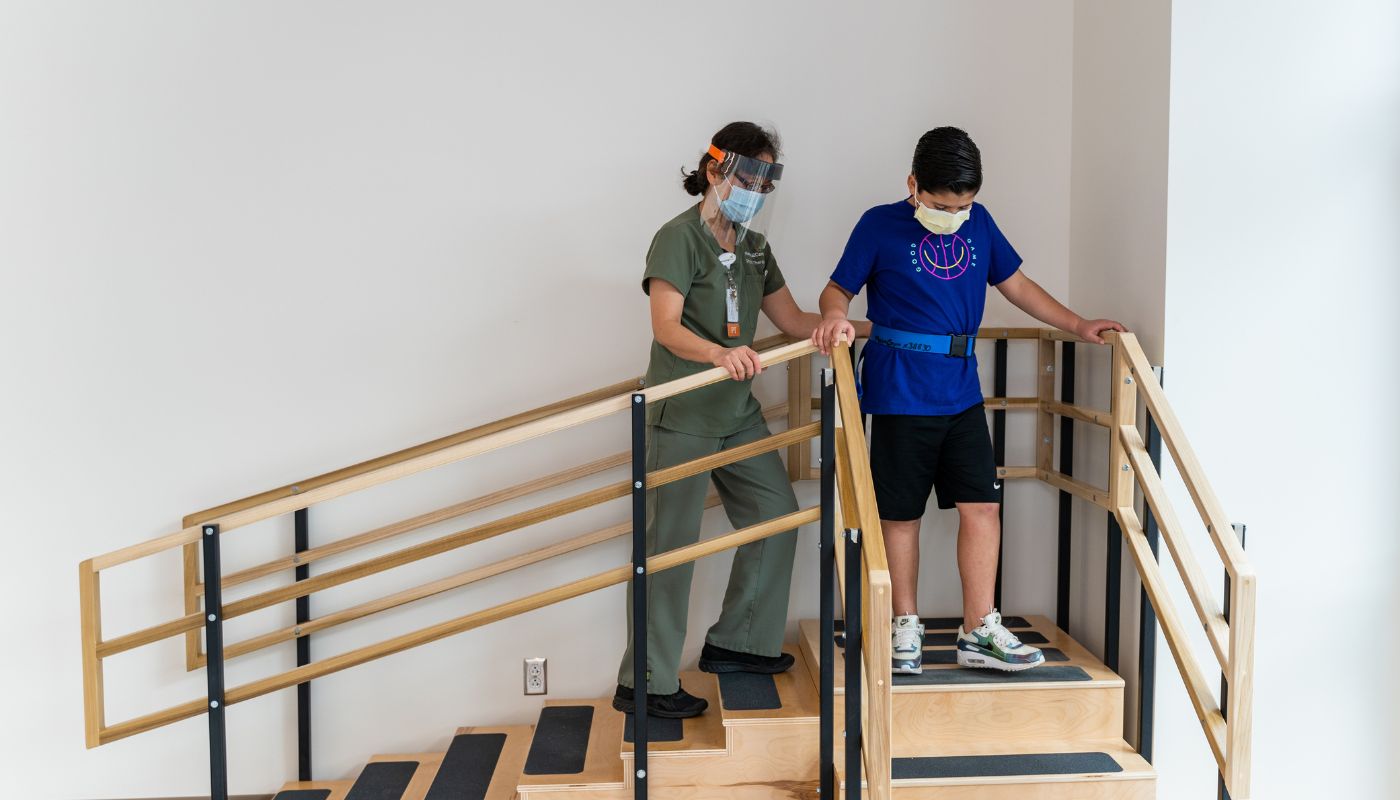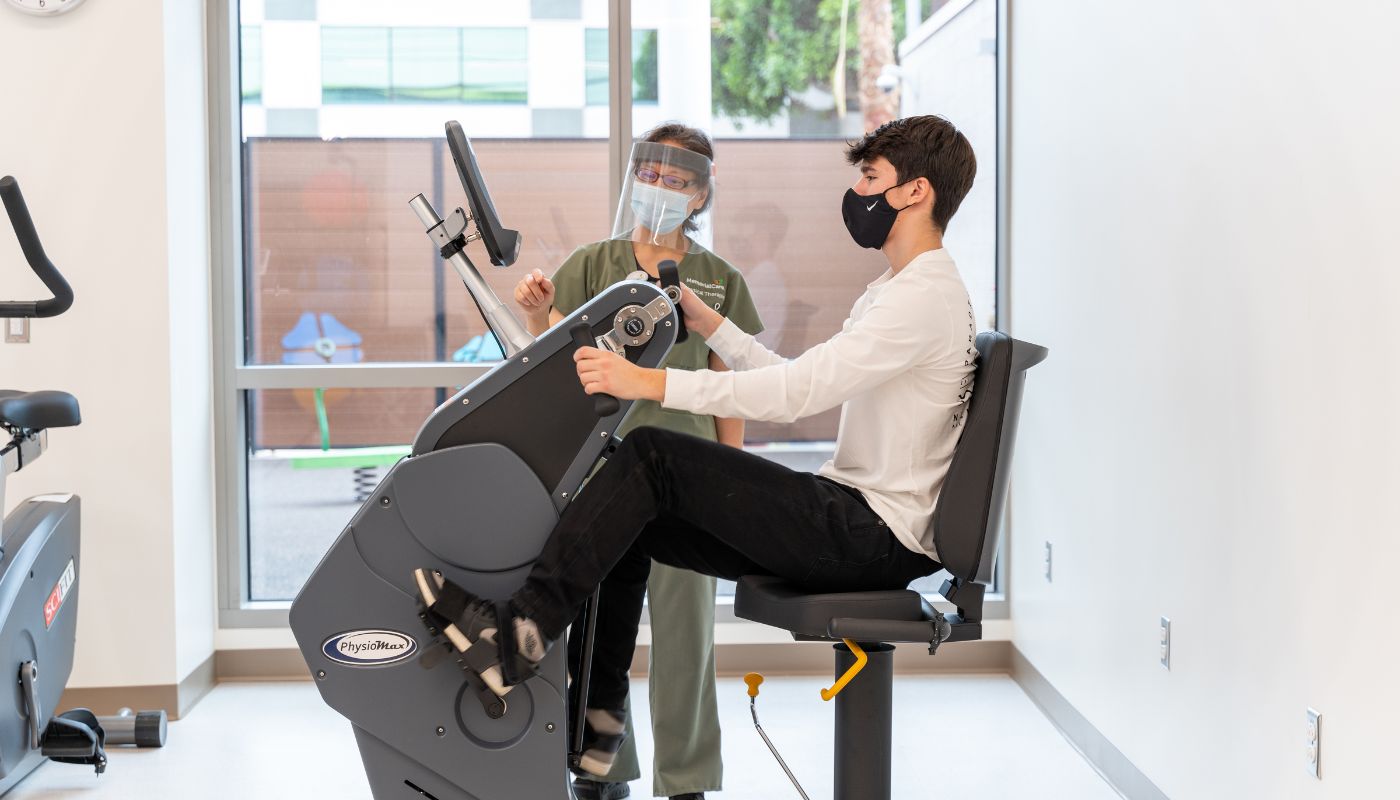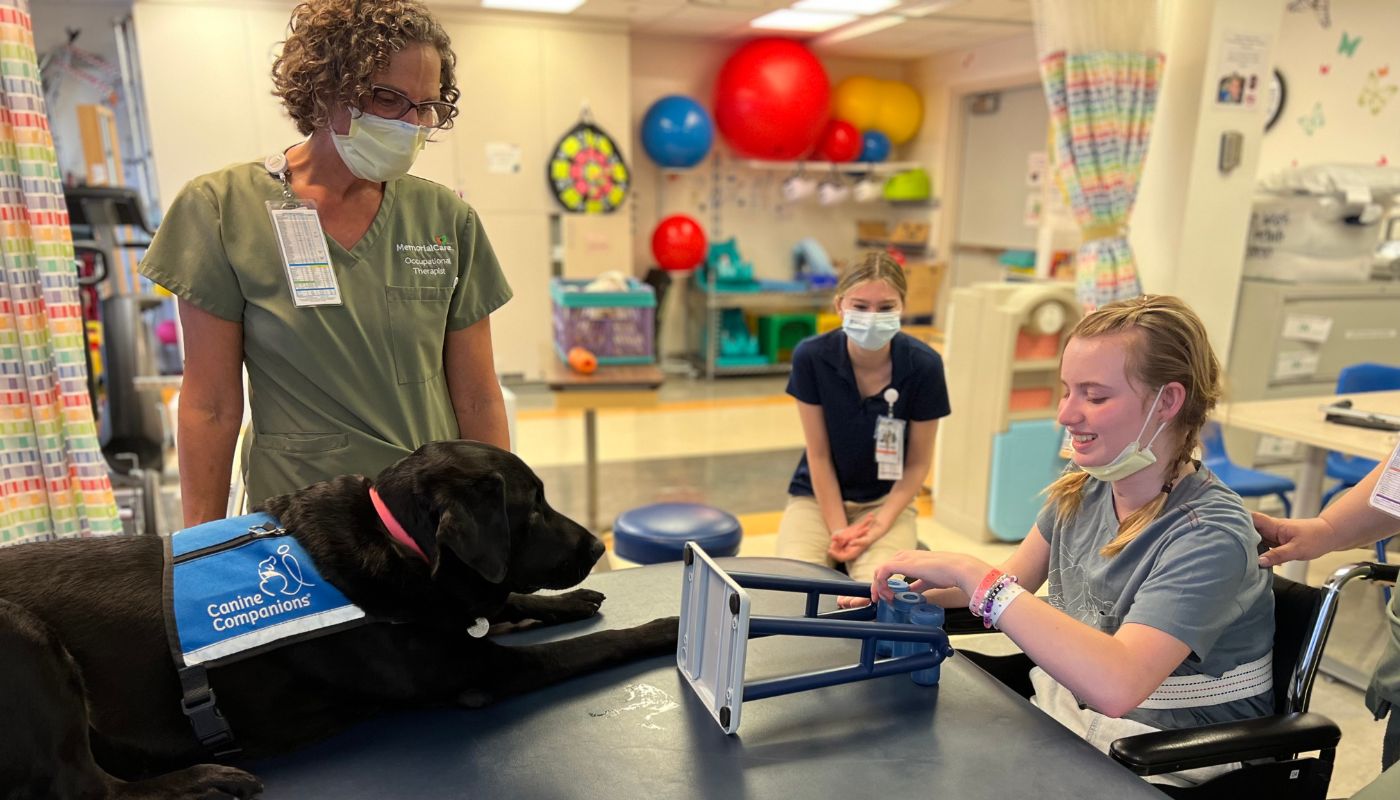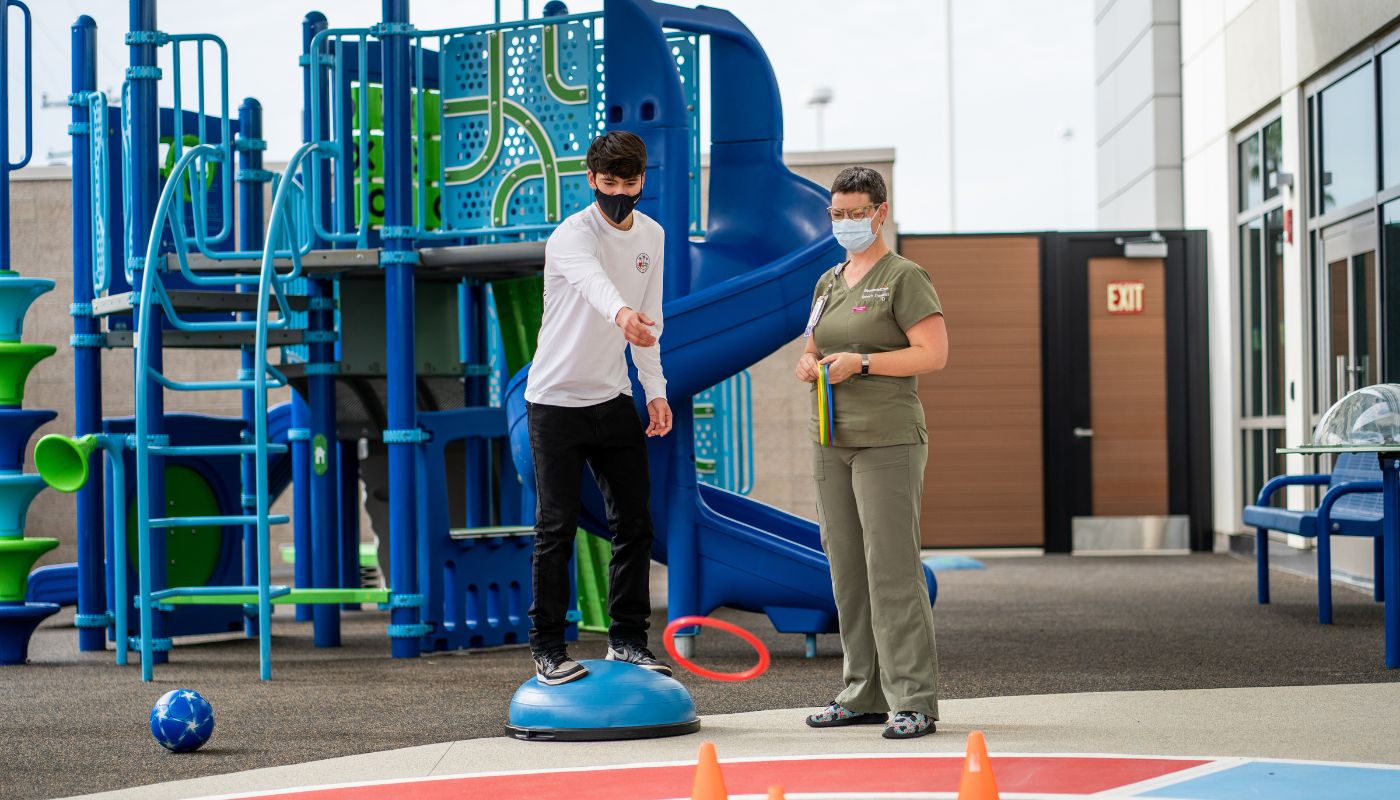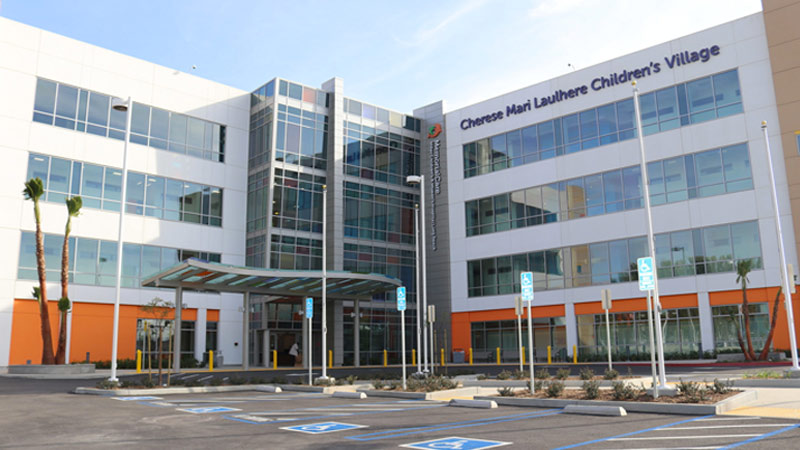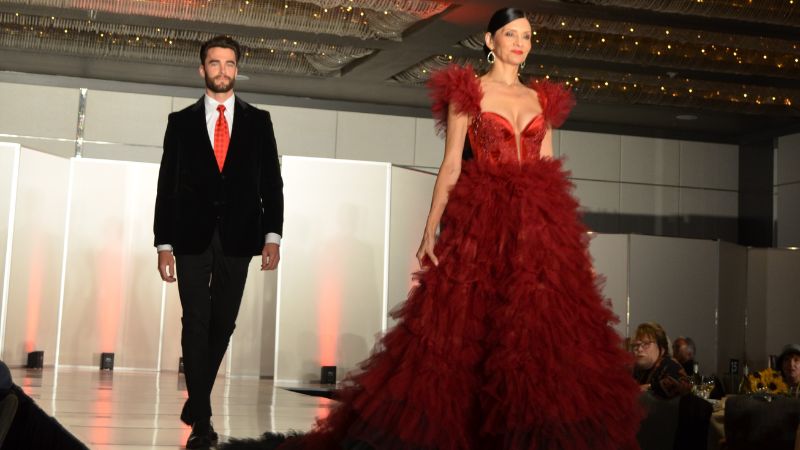The Rehabilitation Center at MemorialCare Miller Children's & Women's Hospital Long Beach offers extensive rehabilitation therapy services for children in the hospital and those who need ongoing physical, occupational, speech and recreational therapy. Our rehabilitation therapists provide developmentally and culturally appropriate evaluations and treatment for children from birth to 21-years-of-age.
The pediatric rehabilitation care team sees children with a wide range of conditions due to disability, injury or illness. Individualized treatment helps children gain or regain as much function as possible while instilling a sense of independence and well-being. The pediatric rehabilitation care team provides services in many multi-disciplinary core care teams throughout the hospital, as well as at the Cherese Mari Laulhere Children's Village.
An expert rehabilitation team, led by board-certified pediatric physiatrists, work hand-in-hand to offer care from nursing, social work, physical therapy, occupational therapy and speech-language therapy to provide developmentally and culturally appropriate evaluations and treatment to help children achieve their emotional, physical, cognitive and social goals. Using the latest technology and research initiatives, the rehab team ensures patients have access to the latest treatment plans and rehab therapies.
Rehabilitation Center Highlights:
- We were one of the first children’s hospitals in Southern California to have a facility dog, who works alongside young rehabilitation patients to help them regain their strength and confidence.
- Our school re-entry team works with the school and family to ensure a successful return to school following the child's hospital stay.
- We offer a broad base of specialized group programs utilizing a peer-based model to help children work on social language, sensory processing, feeding, early language development and improving cleft palate speech.
- We have a total of five pediatric rehabilitation gyms and two outdoor therapy yards, in both the hospital and at the Children's Village, that are equipped with exercise and rehabilitation equipment sized just for kids.
Approved CCS Center
The Rehabilitation Center is a California Children’s Services (CCS) approved Special Care Center (SCC). This means a specially designated multi-disciplinary care team is responsible for all care coordination and case management of a patient in this program. Patients typically qualify for a CCS Special Care Center by medical diagnosis, complexity of their disease and financial status.
Children receive specialized care in a safe and fun environment that offers the challenges faced in their natural settings in the safety of a skilled facility.
The goal of physical therapy is to help improve movement so that children can regain or achieve the highest level of physical functioning. The family also is supported by services that empower them to care for their child and reduce the physical burden of the disability on the family or caretakers. At Miller Children's & Women's, newborns, infants, children, adolescents and young adults receive highly trained care for:
- Developmental conditions associated with prematurity or trauma
- Congenital (genetic) diseases or disorders
- Acquired conditions and disabilities from infection, viruses or injury
- Neuromuscular diseases or disorders
- Cardiopulmonary disorders or diseases (heart and lung disorders including cystic fibrosis)
- Musculoskeletal diseases or disorders, including orthopedic, sports and/or athletic injuries and spinal deformities like scoliosis
- Pre- and post-operative care, especially with complex medical needs
- Endocrine or hormonal disorders, including diabetes
- Skin wounds/burns from injury, trauma, infection or pressure sores
- Connective tissue disorders like juvenile rheumatoid arthritis
- Casting and serial casting
- Other complex medical needs
Helping to Gain Movement
The child's environment and daily needs are taken into consideration as physical therapists (PT) provide thorough evaluations. Physical therapists assess areas such as a child's muscle strength and tone,
joint function and range of motion, gross motor function, sensory and neuromotor development,
posture, balance, coordination, flexibility, exercise endurance and response to activities, pain,
burns and/or wounds.
Information gained from evaluatins are used to provide an individualized treatment plan for each patient. Some children need specialized equipment to help the regain their independence. PTs work with the family and community to make recommendations for wheelchairs, walkers, braces or special equipment for mobility, safety or protection as needed.
A Collaborative Approach
Physical therapists provide care for patients who are inpatients (hospitalized) in most of the care centers, such as acute rehabilitation, pediatric intensive care unit, hematology/oncology and general pediatrics. There also are members of the PT team dedicated exclusively to the NICU on the NICU Therapy Team. In the outpatient specialty centers and clinics, PTs are a part of a few of the outpatient care teams, including Rheumatology, Hypertonicity and Rehabilitation.
The goal of occupational therapy is to help children develop “skills for the job of living” so they can lead independent, productive and satisfying lives. An occupational therapist (OT) helps children adapt to their environment and works to adapt the environment to meet their needs. OTs focus on decreasing the impact of disability, while enhancing quality of life in the areas of self-care, play/productivity and leisure.
Assessment & Intervention
Our occupational therapists collaborate with the family and health care team to complete developmental, functional and feeding/swallowing assessments. Children are then ensured appropriate and individualized intervention that promotes and facilitates the development of skills and behaviors essential to daily living while minimizing the impact of impairment and/or disability on functional independence. Children receive specialized care for:
- Fine motor skills
- Gross motor skills
- Oral motor and feeding skills
- Swallowing function
- Perceptual skills
- Sensory function and processing skills
- Personal-social skills
- Adaptive skills
- Visual motor skills
- Activities of daily living (ADLs)
Children receive intervention that may include direct therapy, bedside programs, home programs, caregiver education, outpatient therapy, recommendations for adaptive equipment and community referrals. Occupational therapists are specially trained to improve children's functioning
and independence using approaches such as range of motion, strengthening, developmental handling, oral motor/feeding/swallowing, electrical stimulation, VitalStim therapy, positioning, ADL training and sensory integration.
A Collaborative Approach
Occupational therapists work with the entire health care team to provide care for patients who are inpatients (hospitalized) in most of the care centers including acute rehabilitation, pediatric intensive care unit, hematology/oncology, general pediatrics and a team dedicated exclusively to the NICU. OTs also are a part of many of the outpatient care teams, including Gastroenterology, Rheumatology, Hypertonicity, Rehabilitation, High-Risk Infant Follow-Up and Craniofacial.
Occupational therapists may assist physical therapists with adapting wheelchairs and walkers or make recommendations for adaptive equipment. An occupational therapist may also work with speech therapists as part of the dysphagia team to evaluate and treat feeding and swallowing difficulties.
Our speech-language therapists serve children and adolescents with a wide range of needs. The goal of speech therapy is to maximize a child’s communication and ability to understand information, to ensure safety while eating and drinking, and to educate family and community members in how they can best support the child. Children and families receive comprehensive care for:
- Communicative and/or Cognitive Rehabilitation
- Voice Disorders
- Resonance Disorders
- Speech Differences due to Cleft Lip/Palate or Other Craniofacial Anomalies
- Feeding and Swallowing Disorders
- Social Communication Disorder
- Early Intervention
Several group therapy programs also are offered for patients.
The First Step
Speech-language therapists meet with the child and family for an in-depth evaluation to determine the needs of the child. Comprehensive evaluations ensure that children and adolescents receive individualized therapy to improve their functioning at home, in school and in the community.
A Collaborative Approach
Speech-language therapists frequently collaborate with local school districts, medical providers and other therapies — occupational, physical and recreational — to provide the most comprehensive level of care. Speech-language therapists provide care for patients who are inpatients (hospitalized) in most of the care centers, such as pediatric intensive care unit, hematology/oncology and general pediatrics. Children and adolescents also receive care from speech-language therapists in the outpatient specialty centers.
Recreational therapy uses play, recreation, and leisure activities to improve the physical, cognitive, social and emotional abilities of children and adolescents. Recreational therapists (RTs) develop care plans in an environment that is conducive with play to promote developmentally appropriate play and recreation. This helps foster a sense of normalcy, understanding and control in the child.
A Child’s Work is Play
Recreational therapists focus on the patient’s leisure time by providing a wide range of play and recreation opportunities during treatment sessions to facilitate increased independent functioning. By identifying their specific leisure and play skills, recreational therapists use their treatment plan and techniques to identify, improve and/or enhance the functional abilities and independence of children. Recreational therapy also establishes new leisure interests for continued growth and increased activity.
Therapeutic recreation may include building confidence, promoting greater self-reliance, enhancing quality of life, easing fear, learning by doing and utilizing leisure time. Interventions that may be used include adaptive leisure skills, animal assisted therapy, developmental play skills, coping/self expression to disability, community reintegration and community resources.
Community re-integration is an important part of a child’s growth. Recreation Therapists may provide leisure education and recommend programs or opportunities that are available for a child in the community.
A Collaborative Approach
Recreational therapists provide care for patients who are inpatients (hospitalized) in acute rehabilitation and general pediatrics and to children who have had a traumatic injury.
On the Miller Children's & Women's campus, there is a full-size indoor pool, set at a comfortable temperature, which is available for daily therapy. Not only is it in a fun setting for kids, but water therapy can help improve functions such as moving, reaching and breathing. It also relaxes muscles and makes movement easier, which may not be found with land-based intervention. The fear of falling down is removed and the warm water reduces body weight reducing the chances of overexertion.
Patients who especially benefit from pool therapy:
- Traumatic injuries
- Orthopedic injuries
- Bone, joint or muscle disorders
- Neurological and/or developmental disorders
- Sensory processing/integration disorders
- Connective tissue disease and rheumatol disorders
Pool therapy is an important part of the patient’s complete therapy program. Water therapy combines instruction, guidance and specialized exercises in a relaxing and therapeutic environment.
Rehabilitation Gyms
Our therapists provide developmentally appropriate physical, occupational and speech therapy in dedicated spaces designed and equipped to address the unique needs of our patients
Your Care Team
The pediatric rehabilitation care team provides family centered care throughout Miller Children's & Women's Hospital Long Beach, as well as for children who receive follow-up care in the Cherese Mari Laulhere Children's Village. Because each child is unique, specialized care teams have been developed to help meet the needs of each individual patient.
Providers




Other Team Members
- Pediatric neuropsychologist
- Physical therapists
- Occupational therapists
- Speech-language pathologists
- Recreational therapists
- Clinical rehabilitation nurse
- Clinical social worker
- Child Life specialist
- Registered dietitian
- Facility dog, Zeta
School Re-Entry Team
- A multi-disciplinary team consisting of a pediatric neuropsychologist, clinical social worker, speech-language pathologist and rehabilitation nurse, work together to ensure patients who receive acute rehabilitation care transition back to their school environment as smoothly as possible.
NICU Therapy Team
- Four dedicated NICU therapists from the pediatric rehabilitation care team — two occupational therapists and two physical therapists — care for critically ill and premature infants in the NICU.
Dysphasia Therapy Team
- Patients who experience difficulties with feeding and swallowing receive specialized assessment and treatment from occupational therapists and speech-language pathologists from the pediatric rehabilitation care team.
Tracheostomy Care Team
- Pediatric rehabilitation therapists are involved in the multi-disciplinary team created to help manage the care of hospitalized children with a tracheostomy at Miller Children's & Women's.
Pediatric rehabilitation therapists also provide assessment and guidance in several specialty care teams such as:
- Craniofacial
- Gastroenterology & Nutrition
- High-Risk Infant Follow-Up
- Hypertonicity
- Neuro-Oncology
- Rheumatology

